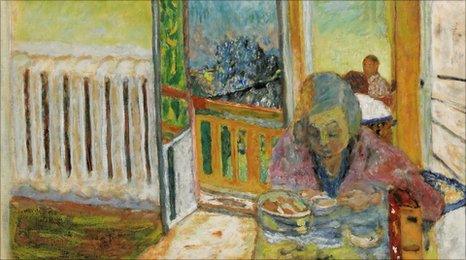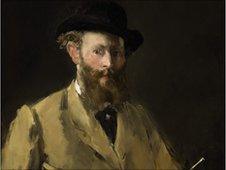Record price fails to impress at arts auction
- Published

Buyers are looking for paintings that will still excite years from now
A self-portrait by Edouard Manet sold for £22.4m at auction in London on Tuesday night.
That was a record for the artist, yet there was disappointment as it was near the bottom of its estimate of £20m-£30m.
Nevertheless, the story the international art market wishes to tell is that the turning point came in February 2009.
Before that, there had been fears the big auction houses might suffer from the crunch hitting the world economy.
Then Christie's in Paris staged the extraordinary sale of artwork, and much else, left by the late Yves St Laurent, who died eight months previously.
The prices fetched were sky high and afterwards, the spin goes, all lingering ripples of disquiet simply disappeared.
The figures since are impressive. A Giacometti sculpture sold for £65m ($104m) at Sotheby's London in February this year.
Last month, even that was eclipsed by the Picasso painting Nude, Green Leaves and Bust, which sold at Christie's New York for $106.5m (£72m).
New buyers
"High net worth people have definitely been moving into collectables as a safer investment over the past two or three years," says Susan Ellis at Datamonitor.
"We're not talking only about multi-millionaires. People at the lower end of the category - maybe with $50,000 in on-shore liquid assets - have moved into art too, although for them jewellery can be the bigger attraction.
"Interestingly, as you ascend to the very rich, that order is reversed."
Ms Ellis says the attraction of art is that it tends to hold its value in the medium-to-long term: "The market believes the right pieces are a safe investment, with a potentially high return over a period of five to 10 years."
The question of what are 'the right pieces' was thrown into relief on Tuesday evening at Sotheby's in London.
Its Impressionist and Modern Art sale was by no means a flop - it made £112m, the company's third-best total for an Impressionist sale.
But neither was it quite the rip-roaring success Sotheby's had been hoping for.
In addition to the Manet failing to meet expectations, several paintings went unsold because they failed to make their reserve price than Sotheby's will be happy with.
Old master
Art journalist Godfrey Barker, who was at the sale, says the sale was evidence that the heat is now at the very top of the market, with the not-quite-masterpiece often struggling to shine.

A self-portrait by Edouard Manet only scraped its estimate price
"The big buyers ask: 'Does that look like a painting for the 21st century?'," he says.
"Probably the Manet suffered because it's starting to look like an old master - which is not what the rich want to invest in. They need something that will still be exciting a decade from now when they come to sell."
Mr Barker says Pierre Bonnard's 'Le Petit Dejeuner' may show what the very wealthy buyer prefers.
It went for £5.5m, well above its estimate.
"It's a very strong painting, and hasn't been on the market before. So it's an easy re-sale if that's what the buyer is planning," says Mr Barker.
It's a very busy week for London's art world, and attention now turns to Wednesday evening's sale at Christie's.
The star items are a Monet water-lily painting and Picasso's Blue Period Portrait of Angel Fernandez de Soto (aka The Absinthe Drinker).
Each painting is valued at £30m to £40m.
If they make such huge prices - or exceed them - the art market will be content to put one slightly under-performing Manet behind it.
More importantly, potential sellers will be encouraged to send their works to market.
- Published23 June 2010